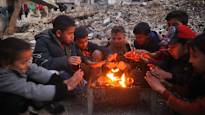The cease-fire agreement between Israel and Hamas goes into effect on Sunday at a critical moment for the residents of Gaza.
This is what Hanken’s assistant professor of production chains and social responsibility says Sarah Schiffling. He is familiar with the problems of aid transport in Gaza.
Another winter is upon us in war-torn Gaza. Very few grants have been received. Residents have exhausted their stocks and savings. There is nothing to sell, and if there is, the prices of basic foods are skyrocketing.
Most of the population of Gaza lives in tent camps and other temporary accommodation.
– Babies have started dying from the cold, says Schiffling.
In this story, we tell you what kind of humanitarian crisis the 15-month-long war has created.
Even more dead than reported
According to the Gaza Ministry of Health, more than 46,600 people have died so far in Israel’s military operations. Science journal of The Lancet published research estimates that hostilities have claimed many more lives, up to more than 64,000.
A study published in the same journal in July estimated that even if the war had ended at that time, the death toll would rise to more than 180,000 as a result of indirect health effects of the war, such as diseases.
There were 36 hospitals in Gaza before the war. Only 16 of them are even partially operational, the World Health Organization WHO said at the beginning of January.
According to the WHO, the capacity of the hospitals is completely insufficient in relation to the enormous need.
You can see the situation in this picture:
According to researcher Sarah Schiffling, malnutrition worsens the health situation. UN Children’s Organization Unicef saysthat 96 percent of children and women in Gaza lack adequate basic nutrition.
In the video, you can see Misk al-Madhun, who fled with his family through Rafah to Deir al-Balah in a tent camp. He has suffered from high fever and malnutrition.
More than 90 percent of residential buildings in Gaza have been either destroyed or damaged. More than 90 percent of Gaza’s population, i.e. 1.9 million people, have lost their homes.
This pair of satellite images shows the destruction in the Jabalia refugee camp in northern Gaza:
The evacuation zones ordered by Israel cover about 86 percent of the area of Gaza.
The map run shows how Gazans have had to flee from one place to another:
A large number of Gazans have packed into tent camps on the coast in the al-Mawas area, which Israel has designated as a buffer zone.
Conditions in the protection zone are miserable. At the tent camp, there is up to a square kilometer roughly packed up to 34,000 people. This is more than ten times the number compared to the population density of Helsinki.
This pair of satellite images shows what kind of tent sea has risen in the buffer zone:
Severe winter conditions have led to hypothermia deaths among newborns. Gaza’s winter is rainy and windy. The temperature drops below ten degrees at night, and tents and other temporary shelters do not protect against moisture.
– People have had to burn plastic waste to stay warm, researcher Schiffling says.
Israel has also bombed the buffer zone several times.
The map below shows the attacks on the Gaza humanitarian zone as verified by the British Broadcasting Corporation BBC from May 2024:
Israel’s November airstrike on al-Mawasi was caught on camera. You can see the impact in the video below.
Only a small part of the aid made it all the way
Only a small part of the collected aid has been used to alleviate the situation of the Gazans, says Schiffling.
Before the war, an average of 500 truckloads of humanitarian aid was brought to Gaza every weekday. During the war, only a fraction of this amount has been aided to Gaza.
This curve shows how, even in the “best” month of the war, the number of grants has halved from before:
According to Schiffling, many factors have made it difficult for help to arrive. First, aid has often gotten stuck in the wheels of Israeli bureaucracy.
– For some products, Israel accepts shipments quickly, and sometimes it rejects them for no apparent reason. Sometimes the trucks have not been allowed across the border, even if the transport has been approved, says Schiffling.
Gaza can only be accessed through a few border crossings. According to Schiffling, inspections of loads often take a long time.
In addition, it is very difficult to get cargo from the border crossing to the destination, says Schiffling. Roads and other infrastructure have been bombed. Sometimes delivering the transports is too dangerous due to the bombings.
– The lack of fuel has led to aid organizations not being able to pick up supplies with their own trucks.
Finally, according to the researcher, the war has led to a state of complete lawlessness in Gaza. First, desperate people started looting aid trucks and warehouses.
– A new problem is organized robbery. Criminal gangs first rob the cargo and then sell the supplies on the black market, says Schiffling.
This video shows people queuing for food in Deir al-Balah last November:
According to Schiffling, the six-week truce is very welcome. He says that a lot can be done in that time to improve the humanitarian situation in Gaza, if Israel does not restrict the delivery of aid.
– During that time, the situation and the need for help can be better assessed. Hospitals can be re-equipped and food stocks filled.
The actual reconstruction, on the other hand, can take decades, according to Schiffling, even if Israel and Hamas sign a permanent peace today.
– Ahead is a complete reconstruction of the school system, healthcare and infrastructure. It will take a very long time before Gaza is even viable.
